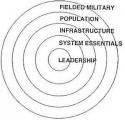Some of the effects of heavy-load bearing would be mitigated by spending money on really good boots, not the cheap ones that are standard issue. Armies are quite happy with pursuing programs like Land Warrior that cost billions of dollars, but they won't pony up the money to buy the troops truly good booots that are genuinely waterproof, reasonably light, provide solid arch and ankle support without killing the calves too badly, and absorb shock well, helping to save the back and knees. Like
here and
here. Note that the first one is no longer in production.










 ) that load-bearing produces. Especially when you're practically doubled over carrying 120-130 pounds on your back. No wonder that I knew guys who were in their mid-twenties that had already had as many as three knee surgeries already. And I still have a big scar on my lower back from where the (cheap) Army-issue frame would cut through my uniform and into my flesh. You were really lucky if you could get a hold of one of the old Airborne tubular frames.
) that load-bearing produces. Especially when you're practically doubled over carrying 120-130 pounds on your back. No wonder that I knew guys who were in their mid-twenties that had already had as many as three knee surgeries already. And I still have a big scar on my lower back from where the (cheap) Army-issue frame would cut through my uniform and into my flesh. You were really lucky if you could get a hold of one of the old Airborne tubular frames. 




Bookmarks